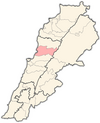Tabarja
Tabarja
طبرجا | |
|---|---|
Village | |
| Coordinates: 34°02′N 35°38′E / 34.033°N 35.633°E | |
| Country | |
| Governorate | Keserwan-Jbeil |
| District | Keserwan District |
| Time zone | UTC+2 (EET) |
| • Summer (DST) | UTC+3 (EEST) |
| Dialing code | +961 |
Tabarja (Arabic: طبرجا) is an ancient coastal village in Lebanon, situated in Kesrouan, 26 km (16 mi)
Etymology[edit]
Tabarja has been known by various names throughout its history. It is identified with the coastal town of Trieres in Polybius' Histories. The historian places the Lycus river, Calamus, and Trieres between Beirut and Batrun.[1] In the 6th-century AD pilgrimage guide Antonini Placentini Itinerarium,Trieri (Trierim civitatem) is mentioned and placed between Beirut and Byblos.[2] Trieres was a Greek exonym meaning "trireme" which implies the location of the settlement next to a harbor.[3] According to Lipiński, the name Tabarja (Tabarga) stems from Tiberias through an Arabic dialectal change of -iyya in "Tabariyya" into "Tabarigg", or a Frankish process of palatalization to "Tabarge".[a] The settlement was so-called after emperor Tiberius, like the town built in the first century AD on the western shore of the Sea of Galilee.[3] This is corroborated by 13th-century AD Arab geographer Yaqut al-Hamawi, who lists a Tabarayya in as-Sham besides the one in Palestine.[4][3] As for the Semitic root of the Greek exonym Trieres, Lipiński suggests "traʿ- ʾarʿā" which means in Aramaic "the gate of the country"; a hypothesis that is corroborated by the Latin name of "Passus Pagani" (the Pass of the Countrymen" mentioned by William, a 12th-century chronicler and archbishop of Tyre.[5][3] The Aramaic name dates to the Persian period, when it indicated the geographical frontier between the lands of the kingdoms of Sidon and Byblos.[3]
Local lore[edit]
Local tradition reports that a rich king called Bargis lived in this town in the ancient times. This story could date to when Tabarja was still "Tiberias".[3]
Notes[edit]
References[edit]
Citations[edit]
- ^ Lipiński 2004, p. 25.
- ^ Antoninus of Piacenza 1889, p. 1.
- ^ a b c d e f g Lipiński 2004, p. 26.
- ^ al-Rūmī al-Ḥamawī 1868, p. 513.
- ^ van Berchem 1902, p. 397-399.
Bibliography[edit]
- al-Rūmī al-Ḥamawī, Yāqūt Ibn-ʻAbdallāh (1868) [13th century AD]. Jacut's Geographisches Wörterbuch: S - f [Mu'jam al-Buldān (Arabic: معجم البلدان) "Dictionary of Countries"] (in Arabic). Vol. 3. Brockhaus.
- Antoninus of Piacenza (1889) [6th century AD]. Gildemeister, Johann (ed.). Antonini Placentini Itinerarium (in Latin). Berlin: H. Reuther. OCLC 18538787.
- van Berchem, Max (1902). Le royaume de Jérusalem et le livre de M. Röhricht [The kingdom of Jerusalem and the book of M. Röhricht] (in French). Imprimerie nationale.
- Lipiński, Edward (2004). Itineraria Phoenicia. Orientalia Lovaniensia analecta. Uitgeverij Peeters en Departement Oosterse Studies. ISBN 978-90-429-1344-8.
External links[edit]
- Tabarja - Kfar Yassine, Localiban


